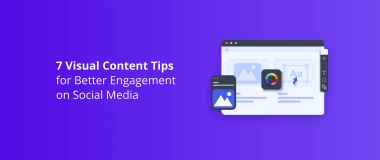In today’s business landscape, having a killer social media presence is an absolute must for every small business. We’re talking about 6 billion active social media users by 2027! Platforms like Facebook, Instagram, Twitter, Pinterest, and TikTok are goldmines when promoting products or services or connecting with target audiences. So, if you want to up your game and achieve serious success, prioritize your marketing strategy on social media. It’s the real deal!
Venturing into the realm of social media for a small business can feel overwhelming, but worry not! We’re here to lighten the load and unveil the secret ingredients to success, designed specifically for you. Keep reading this blog post if you’re seeking answers to:
- What exactly is social media marketing, and what are the pillars that your marketing plan should rest upon?
- How to create an epic social media strategy for your small business?
- How to choose the right social media for your business?
- How to create a content strategy that actually works?
- What metrics should you be tracking to avoid getting lost in data.
Before we reveal all the juicy tips, let’s go over the basic ingredients first, shall we?

Exploring the Depths of Social Media Marketing
Social media marketing (SMM) is a type of internet marketing that leverages social media applications as a tool for promotional purposes. So, if you’re serious about building your brand and achieving your business goals, then marketing on social media is your game.
The Benefits of Social Media Marketing
In a nutshell, social media marketing is a total win-win. It boosts your brand, connects you with your dream audience, gives you insights, saves you money, drives traffic, showcases credibility, and keeps you ahead of the pack.
Now, let’s dive into why it’s so amazing:
- Boosted brand visibility. With social media, you can put your brand in front of a large audience. You’ll get more eyeballs on your business, and that means more people will know who you are.
- Engaging with your dream audience. Social media lets you connect directly with your target customers. You can have conversations, answer questions, and build real relationships. It’s like having a direct line to your fans and followers.
- Insights that hit hard and deliver results. The data you can gather from social media is gold. You’ll get insights into what your customers like, their preferences, and the latest trends. Armed with this information, you can fine-tune your marketing strategies and make your customers even more happier.
- Cost-effective magic. Forget spending a fortune on traditional advertising. Social media marketing is budget-friendly and can pack a serious punch. You can target your ads to specific demographics, making every dollar count.
- More traffic, more conversions. Want more people visiting your website? Social media is your secret weapon. By cleverly crafting irresistible content and dropping in links, you’ll drive loads of traffic. And more traffic often leads to more conversions and sales!
- Stay ahead of the pack. Being active on social media shows you’re on top of your game. You’ll be in the loop with the latest trends and features and your competitors green with envy.
Let’s be real though – SMM has its own set of challenges, especially for small businesses. Things like managing accounts, dealing with algorithms, standing out from the competition, handling negative feedback, relying on platform policies, measuring ROI, and navigating information overload can be overwhelming. However, here’s the secret – despite these challenges when you combine everything with other marketing efforts, the benefits of social media marketing will work wonders for your brand!
Readers Also Enjoy: [Infographic] 24 Fundamental Еmail Marketing Stats – DevriX
Pillars of Social Media Marketing [And How to Make the Most of Them]

To achieve social media marketing success, it’s important to build your efforts around a few key pillars. These serve as the foundation of powerful campaigns that can resonate with your target audience, encourage interaction, and ultimately boost your business growth.
- Strategy. Get the ball rolling by crafting a kickass social media strategy that aligns with your business goals and target audience. Dive into your audience’s preferences, interests, and pain points, then create compelling content that captivates and resonates with them. Don’t be afraid to mix things up by adding videos, infographics, or behind-the-scenes glimpses. Remember, one of the secret ingredients is to deliver content that not only informs but also entertains and inspires.
- Content. Nail down the platforms and content styles that totally match your brand’s vibe. Whip up top-notch, mind-blowing content that demands attention and ignites engagement.
- Engagement. Get in the groove and actively connect with your audience. Show them some love by responding to their comments, messages, and awesome user-generated content. Let the conversation flow and keep the engagement party going strong.
- Analytics. Stay on top of your game by regularly diving into your social media metrics. Unleash the power of data and gain valuable insights that fuel your decision-making process. Let the numbers be your guide as you rock the social media scene with data-driven strategies and epic results.
- Advertising. Finally, consider incorporating targeted advertising. With this you can optimize your social media marketing efforts and achieve remarkable results by broadening your reach.
How to Set Up the Best Social Media Strategy for Your Small Business
As you embark on your social media marketing journey, always remember that patience is the secret ingredient to success. Social media is a marathon, and having a solid strategy is paramount. Don’t fall into the trap of simply “posting” and hoping for natural growth. It won’t happen. Yes, you should definitely embrace the challenge, take risks, experiment, and be ready to adapt, but always within the context of your social media strategy. It’s important to be consistent and align your overall objectives with the guidelines of your social media strategy. Remember, mediocrity is not an option.
Gain Clarity and Identify Your Target Audience
In the vast sea of users, it’s crucial to know who you’re speaking to. Without knowing your target audience, your message will get lost. Moreover, you won’t be able to select the appropriate social media goals and social media channels to effectively communicate your message.
- Define your product. Clearly understand the unique value your product or service brings and the problem/s it solves.
- Analyze current customers. Look for common characteristics, demographics, and interests among your existing customer base.
- Conduct market research. Gather insights through online surveys, focus groups, or interviews to understand potential customers’ preferences and needs.
- Use social media analytics. Most platforms offer tools that analyze and measure the demographics of their users as well as the engagement and behavior of their audience. Use them wisely.
- Monitor the competitors. Keep an eye on competitors’ social media presence and engagement, assessing if their audience aligns with yours.
- Create buyer personas. Develop detailed profiles of your ideal customers, including demographics, interests, behaviors, and motivations.
- Test and refine. Continuously adapt your strategies based on feedback and data. Regularly analyze and adjust your approach.
Remember, understanding your target audience is an ongoing process. Stay open to feedback, analyse data regularly, and adapt your strategies to effectively engage with the right people on social media.
Readers Also Enjoy: 7 Visual Content Tips for Better Engagement on Social Media
Set Your Goals S.M.A.R.T
When it comes to setting goals in business, making them S.M.A.R.T is like striking gold. These Specific, Measurable, Achievable, Relevant, and Time-bound goals bring clarity, focus, and direction to your journey. They empower businesses to create actionable plans, track progress, and stay on track with their marketing strategy.
An example of a SMART goal would be to increase Instagram engagement by 15% within a two-month period using a targeted content strategy.
For this you will need to first analyze the demographics of your audience as well as their interests so you can create engaging and relevant content. Then, you should devise a schedule to help you post content regularly and actively engage with your audience by initiating conversations and responding to comments. Next, it is important to track engagement and performance metrics to see if you need to improve your strategy so that you can achieve the desired increase in engagement initially specified.
Align Your Business Goals to Your Social Media Goals

Aligning your social media goals with your overall business objectives ensures that your social media efforts are contributing directly to the success of your small business. For example:
- If your business goal is to increase brand awareness, your social media goal could be to increase your follower count, reach, and engagement metrics.
- If better website traffic is your goal, then increasing click-through rates and referral traffic from social media platforms is important.
- If you want to generate leads, you could increase conversions through lead generation campaigns and capture email sign-ups through social media channels.
- If your goal is to improve customer satisfaction, you might want to enhance response time and the quality of customer support on your platforms.
- If launching a new product or service is what you want to do, your social media goal could be to create buzz, generate excitement, and drive pre-orders or registrations through online campaigns.
Keep It Real and Evaluate Your Social Media Resources
Now that you’ve covered all the bases, from understanding your target audience and social media goals to conducting competitor research, you might feel like you have it all together. Maybe you’ve even started on a snazzy PowerPoint presentation and a bunch of spreadsheets. However, here’s the thing – everyone’s doing that. Hence, take a moment to add one more secret ingredient to your recipe for success: evaluate yourself!
You know what the major challenge small businesses face? It’s the lack of consistency due to limited resources and time constraints. Many give up too soon because being consistent is tough. However, it’s important to remember that consistency doesn’t mean posting frequently. Please, don’t go all-in and post five times a day for a month, only to give up when you don’t see immediate results at the cash register. After all, it’s about maintaining a steady presence and delivering value to your audience!
Here are five ways to evaluate the consistency of your social media efforts:
- Time Management. Determine the amount of time you can realistically dedicate to social media. How many hours per week can you allocate towards planning, creating content, scheduling posts, and engaging with your audience?
- Content Creation. Evaluate your content creation capabilities. Determine if you have the skills and resources to create high-quality visuals, videos, or written content in-house. If not, consider outsourcing or utilizing user-generated content.
- Scheduling Tools. There are tools that can help you streamline your posting process. Evaluate the different options and choose the one that fits your budget and requirements. Automation can help you maintain a consistent posting schedule.
- Team Collaboration. Assess whether or not you have team members who can contribute to your social media efforts. If so, delegate responsibilities, establish roles, and make sure that the workload has been distributed properly.
- Analytics and Feedback. Use social media analytics to track your performance. Evaluate engagement, reach, and conversions to identify any trends and/or areas for improvement. So, gather feedback from your audience and adjust your strategy accordingly.
Choose the Right Social Media Platform for Your Small Business
Once you have a clear understanding of your target audience, buyer personas, goals, etc., your social media strategy should be firmly established and have a solid foundation.
Now is the time to make a crucial decision: What social media platforms are right for your small business? Remember, quality trumps quantity, so choose wisely and focus your efforts where it truly matters.
Readers Also Enjoy: User Attention Span: the Biggest Challenge for Marketers [2022]
Begin by Focusing on Your Target Audience
When choosing a social media platform, your audience is the most important factor to consider. It surpasses everything else. So, even if a platform has a huge user base, like Facebook, if your audience is more active on TikTok, that’s where you should concentrate your efforts. However, keep in mind that Internet users have an average of 6.6 social media accounts, so it’s important to consider this as well, especially if you want to expand your target audience.
Keep In Mind the Nature of Your Business
Consider the products and services you offer, along with your brand image, tone, and values. For instance, if you’re a B2B company, focusing your efforts on a professional platform like LinkedIn is a logical choice. On the other hand, if your target demographic consists mostly of women aged 30 and above, Facebook is the ideal platform for your business.
Best Social Media Platforms for Small Businesses in 2023
- Facebook. With 2.9 billion monthly active users, Facebook is a powerhouse platform for B2C companies. A good number of its users are between the ages of 35-44, making it an ideal space to target this age group. If you’re looking to connect with a large and diverse user base, Facebook is the go-to social media platform.
- YouTube. With 2.6 billion monthly active users, YouTube is a dynamic platform suitable for both B2C and B2B companies. Its user base is generally between the ages of 15-45, making it an ideal space to engage with younger audiences. As the world’s second-most-visited website, YouTube offers immense potential for reaching a global audience and delivering compelling video content.
- Instagram. With 2 billion monthly active users, Instagram is a prime platform for B2C companies to thrive. Its most active demographic falls between the ages of 18 and 34, making it an ideal space to to visually showcase your brand and engage with a wide range of users.
- TikTok. TikTok, with an impressive 1 billion monthly active users, is an ideal platform for B2C companies to explore. It attracts a highly active demographic, primarily females aged 18 to 24, offering a unique opportunity to engage with this youthful and trend-focused audience.
- SnapChat. Snapchat, with a user base of 538 million monthly active users, presents a valuable platform for B2C companies to engage with their audience. The most active demographic on Snapchat comprises females aged 15 to 29, captivating the youth-oriented and trend-conscious demographic.
- Pinterest. Pinterest, with a monthly active user base of 463 million, is a highly suitable platform for B2C companies. It attracts a predominantly female audience (60%), presenting an ideal demographic for businesses targeting this group.
- LinkedIn. LinkedIn, with a monthly active user base of 310 million, is an ideal platform for B2B companies looking to connect with professionals and generate leads. The most active demographic on LinkedIn comprises men aged 25 to 34, representing a valuable target audience for businesses operating in the B2B space.
Readers Also Enjoy: Content Marketing for Small Business: A Comprehensive Guide
Get Creative and Consistent
Finally, it’s time to start creating content. Remember the golden rule: consistency before frequency. Focus on quality over quantity, ensuring that each piece of content you publish provides value to your audience. By maintaining a consistent schedule and delivering valuable content, you’ll build trust, engage your audience, and establish your brand as a reliable source of information and inspiration.
The Rule of Third
In content marketing the rule of thirds is a guideline for diversifying your content. So, it’s a good idea to divide your content into three categories: educational, entertaining, and promotional. After all, one-third of your content should educate your audience, one-third should entertain them, and one-third can be promotional in nature.
Content Pillars
Content pillars are the foundation of your content strategy. They’re the main themes or topics that you consistently focus on to deliver value to your audience.
To use content pillars effectively, start by identifying 3 or 4 core areas that resonate with your audience. For example, these could be topics like tips and tricks, industry insights, or behind-the-scenes glimpses. Then, structure your content plan around these pillars, ensuring that each piece of content connects to one or more of the key themes.
This is how you can maintain consistency, build your brand’s authority, and create content that truly resonates with your target audience.
The Content Calendar
A content calendar can be used to outline what type of content to create and when to post it.
Having a content calendar is important because it allows you to plan ahead, align your content with your business goals, and maintain a consistent brand voice. In addition, it helps you avoid last-minute scrambling and ensures that your social media presence is strategic and intentional.
When creating a content calendar, there are a few basic principles to keep in mind:
- Consider your audience’s preferences and interests.
- Incorporate a mix of content types, such as educational, entertaining, and promotional.
- Schedule content at optimal times to reach your target audience effectively. Leaving room for flexibility to adapt and respond to current events or trending topics.
The Importance of Social Media Marketing Metrics
Keeping an eye on the social media metrics is vital to the success of your marketing efforts. Metrics provide valuable insights into the performance of your social media campaigns, helping you understand what’s working and what’s not. As a result, you can make data-driven decisions, optimize your strategy, and ensure that your efforts are driving the desired results. They also allow you to measure your return on investment (ROI) and continually improve your social media marketing to achieve your business objectives.
Navigating through the sea of social media metrics can be challenging, especially for small businesses and non-professionals. To simplify things, here are some important metrics to focus on:
- Reach. Measure the number of unique users who can see your content. It indicates your brand’s visibility and potential audience size.
- Engagement. Track likes, comments, shares, and clicks to understand how users are interacting with your content. It shows the level of interest and connection.
- Conversion Rates. This determines the percentage of users who take a desired action, such as making a purchase or filling out a form. It helps assess the effectiveness of your social media strategy when driving conversions.
- Audience Growth. Monitors the growth of your followers or subscribers. It indicates the size and reach of your brand’s online community.
- Click-through Rate (CTR). Measure the rate at which users click on your content or ads. It reflects the relevance and effectiveness of your messaging.
By focusing on these important metrics, small businesses can gain valuable insights into their social media performance. Also, they can make informed decisions on whether they need to optimize their strategies for better results.
Wrap Up
Want to know another secret ingredient towards mastering social media for small businesses? Relax! Enjoy yourself, and find inspiration in everything you do! While strategy and execution are important, it’s not like facing the Spanish Inquisition. Success will come when you are genuinely enjoying your social media journey. Remember, everyone’s path is unique, so embrace your own and have fun along the way!




